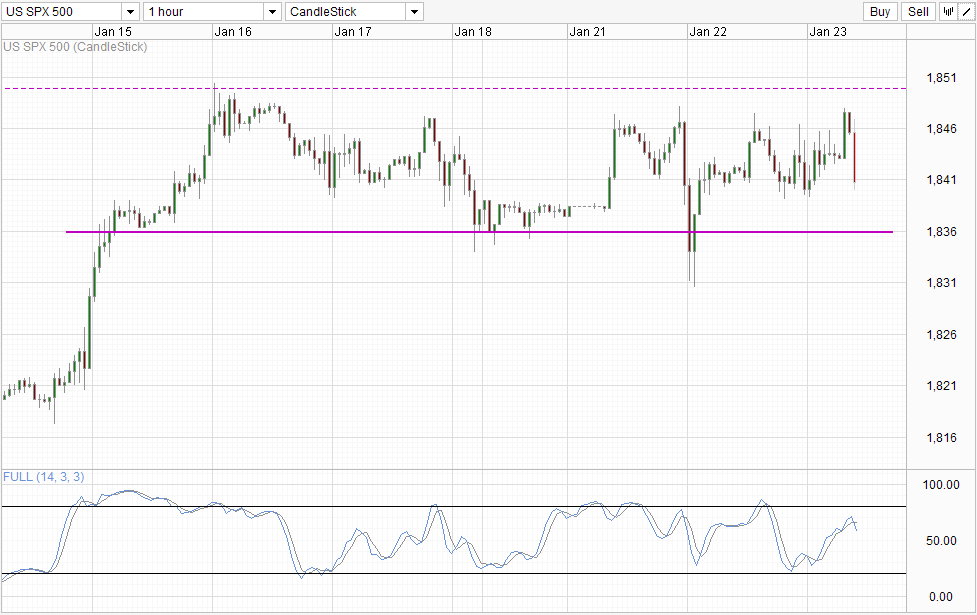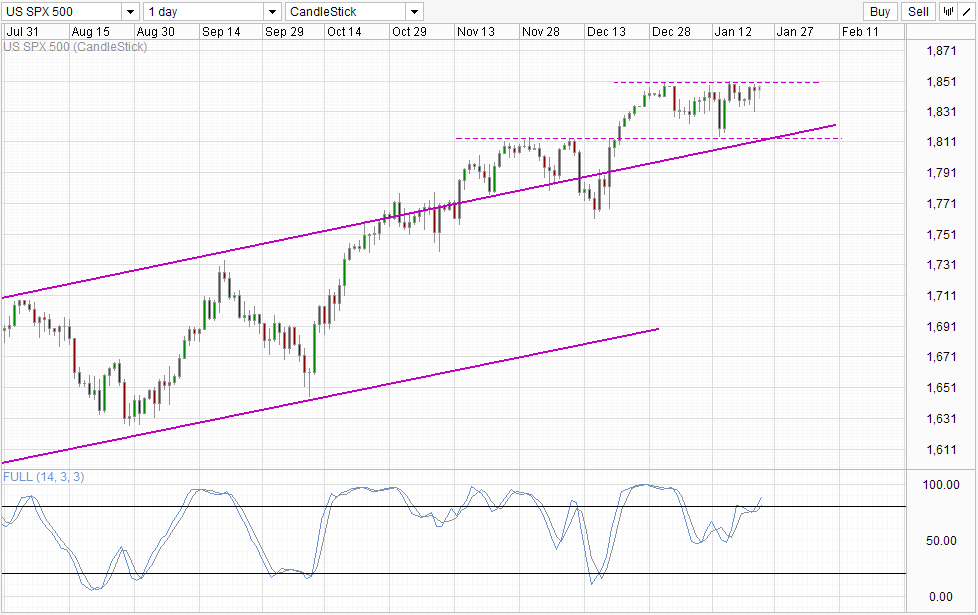S&P 500 closed 1.06 point higher (0.06%), however as prices were weaving in and out between gains and losses, it is more apt to say that prices are trading flat rather than mildly bullish. This flat trading was a result of uneven earnings reports, which caused market to be slightly more cautious as there were already signs of overbought in Stocks given the strong bullish rally in 2013.
Interestingly, yields on US 10Y and 30Y Treasurys actually rose, while Gold prices actually traded lower. All these are the hallmark of bullish sentiment, and the fact that Stocks are trading less than bullishly is strange. Seeing that USD actually traded stronger as well, one starts to wonder if QE tapering concerns played any parts in yesterday’s mixed trade. If indeed some quarters of the market is concern over the FOMC meeting next week, then traders worrying about a fundamental shift in broad market risk sentiment can rest easier. This is because QE concerns is already out of vogue right now due to the certainty that current QE program will definitely end before we see 2016. In fact, looking at price reaction to bullish/bearish US economic numbers, we can ascertain that market is no longer concern about QE even before the 1st taper was announced in December.
Hourly Chart
Hence, on the sentiment front broad bullish trend should remain in play even though US traders are appearing on the jittery front. It should also be noted that S&P 500 futures actually rallied this morning when Asian market started trading, hitting higher than what US session managed to achieve earlier. Prices is trading lower right now but that is more due to technical pressure and the weaker than expected Chinese Manufacturing PMI surveyed by HSBC and not due to inherent bearish sentiment of broad market.
Certainly this doesn’t mean that S&P 500 will rally up from here, but the risk of a bearish capitulation from here is low, and we should see prices being supported between 1,830 – 1,836 if we even reach there to begin with. That being said, it should also be noted that US traders are slightly more bearish than the rest of the global counterparts. Looking at past 2 day action, futures have always been more bullish during Asian/European hours only to see US session pegging back prices back down once again. This is yet more evidence that a strong bearish push is unlikely in the immediate future as global traders are not in agreement on where price should go, but it is still possible that Asian/European traders will turn bearish in the future should current uncertainty drag on or if more data proves to be bearish.
Daily Chart
This fits nicely into the daily chart technical outlook, where the risk of price heading towards rising Channel Top increases if 1,850 is not broken. Similarly Stochastic readings are already within the overbought region, favoring a potential bearish cycle moving forward . However, there is no evidence that a bearish momentum is in play yet, which goes in line with the above analysis that affirms that there shouldn’t be any immediate strong bearish sell-off in the short-term.
More Links:
AUD/USD – Returns to Key 0.88 Level
EUR/USD – Continues to Loiter around the Key 1.3550 Level
GBP/USD – Pound Surges As UK Unemployment Dips to 7.1%
This article is for general information purposes only. It is not investment advice or a solution to buy or sell securities. Opinions are the authors; not necessarily that of OANDA Corporation or any of its affiliates, subsidiaries, officers or directors. Leveraged trading is high risk and not suitable for all. You could lose all of your deposited funds.





